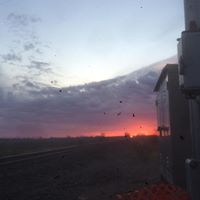Clarence L Miller
age ~82
from Beach City, OH
- Also known as:
-
- Clarence Leroy Miller
- Clearance Miller
- Clarence Lmiller
- Phone and address:
-
426 W Main St #105, Beach City, OH 44608
3307562797
Clarence Miller Phones & Addresses
- 426 W Main St #105, Beach City, OH 44608 • 3307562797
- Dalton, OH
- Chicago, IL
- 4805 Windfall Rd #105, Medina, OH 44256
- Navarre, OH
Lawyers & Attorneys

Clarence Adam Miller Jr. - Lawyer
view sourceLicenses:
Texas - Eligible To Practice In Texas 2004
Education:
Tulane University Law School
Degree - Doctor of Jurisprudence/Juris Doctor (J.D.)
Graduated - 1957
Degree - Doctor of Jurisprudence/Juris Doctor (J.D.)
Graduated - 1957
Name / Title
Company / Classification
Phones & Addresses
Principal
Miller S Garage
General Auto Repair
General Auto Repair
2577 W 9 Ave, Gary, IN 46404
Principal
Miller Farms
General Crop Farm
General Crop Farm
12352 Wooster St NW, Massillon, OH 44647
Treasurer , Director
Mt Ararat Missionary Baptist Church, Inc
Chairman, Director, Vice President
The Ambassadors of Black Youth, Inc
Pastor
St. Mathews Community Church
Religious Organization
Religious Organization
426 Main W, Beach City, OH 44608
JOHN KNOX PRESBYTERIAN CHURCH (U.S.A.)
North Olmsted, OH
WILLIAMS ELECTRIC, INC
Swept Clean
Garbage Collection · Hauling Services · House Cleaning
Garbage Collection · Hauling Services · House Cleaning
127 E 69 St, Chicago, IL 60637
7734881877
7734881877
Us Patents
-
Swimming Pool Construction And Method Of Making The Same
view source -
US Patent:42637597, Apr 28, 1981
-
Filed:Mar 15, 1979
-
Appl. No.:6/020625
-
Inventors:Clarence J. Miller - Canton OH
-
Assignee:Bradley Enterprises, Inc. - Canton OH
-
International Classification:E04B 100
E04H 316 -
US Classification:521697
-
Abstract:An in-ground swimming pool which utilizes a relatively flexible, continuous sheet-like wall member in combination with a bottom construction which is formed from polyurethane foam. The polyurethane foam bottom is reinforced at the surfaces of concave curvature with rail-like concrete members to which the foam is bonded. Also disclosed is a method of forming the polyurethane bottom which consists of applying a relatively thin coating of polyurethane foam to the bottom excavation and immediately placing a sheet of polyethylene, 2 to 4 mils thick, over the foam before the foam has set, conforming and adhering the polyethylene sheet to the foam and earth surface. The final steps include applying a series of polyurethane foam layers by spraying over the polyethylene sheet to achieve a desired thickness. By following the procedures disclosed, the foam surface can be controlled to obtain the desired pool bottom smoothness.
-
Cooling Tower With Fluted Wall
view source -
US Patent:42619319, Apr 14, 1981
-
Filed:Aug 3, 1979
-
Appl. No.:6/063204
-
Inventors:Elmer W. Rothrock - Hinsdale IL
Clarence D. Miller - Naperville IL -
Assignee:Chicago Bridge & Iron Company - Oak Brook IL
-
International Classification:B01F 304
-
US Classification:261109
-
Abstract:A cooling tower self-supporting vertical shell essentially circular in horizontal section and wider at the base than at the top, said shell comprising a series of courses set one above the other with each adjacent upper course supported by the course beneath it, most of the courses from at least near the bottom to the shell top portion constituting a frusto-conical shell with vertical flutes, and the diameter of the bottom of each course being about equal to the diameter of the top of the course beneath it.
-
Method Of Constructing A Swimming Pool
view source -
US Patent:42273617, Oct 14, 1980
-
Filed:Mar 16, 1979
-
Appl. No.:6/020950
-
Inventors:Clarence J. Miller - Canton OH
-
Assignee:Bradley Enterprises, Inc. - Canton OH
-
International Classification:E04H 316
-
US Classification:52742
-
Abstract:A method of constructing a swimming pool which includes the steps of forming an excavation of desired size and shape in the ground, the excavation including a footing area, placing polyethylene film over the footing area and a portion of the remaining excavation surface, setting a wall member on the footing area, pouring a concrete footing on the footing area to embed a portion of the wall, applying a groove-forming device to the wall, pouring additional concrete to form the pool bottom, removing the groove-forming device to expose a groove, and filling the groove with caulking material. An alternative method of forming the pool bottom includes the steps of spraying layers of polyurethane foam on the excavation to form the pool bottom.
Isbn (Books And Publications)




Complete Works of St. Thomas More Vol. 10: The Debellation of Salem and Bizance
view sourceAuthor
Clarence H. Miller
ISBN #
0300033761

The Yale Edition of the Complete Works of St. Thomas More: The Confutation of Tyndale`s Answer
view sourceAuthor
Clarence H. Miller
ISBN #
0300062311



License Records
Clarence H Miller
License #:
2892 - Expired
Issued Date:
Apr 20, 1957
Renew Date:
Dec 10, 1986
Expiration Date:
Dec 10, 1986
Type:
Professional Engineer
Clarence R Miller Jr
License #:
RS145216A - Expired
Category:
Real Estate Commission
Type:
Real Estate Salesperson-Standard
Classmates

Clarence Miller
view sourceSchools:
Pine Grove Area Middle School Pine Grove PA 1997-2001
Community:
Sabina Madison, Scott Felty

Clarence Miller
view sourceSchools:
Port Huron High School Port Huron MI 1965-1969
Community:
Philip Miller, Diane Merriman, Doug Richardson

Clarence III Miller
view sourceSchools:
Pierson Elementary School Flint MI 1985-1991
Community:
Paula Herzog, Tammy Gean, Marianne Griggs, Alvin Clarke

Clarence Miller
view sourceSchools:
South High School Springfield OH 1988-1992
Community:
Marla Glaser, Carol Snide, Deborah Blinn

Clarence Miller
view sourceSchools:
Eichelberger High School Hanover PA 1946-1949
Community:
Mary Transue, Jack Stull, Raymond Mason, Judy Goodermuth

Clarence Miller
view sourceSchools:
Elmwood Elementary School Springfield OH 1957-1960, Schaefer Junior High School Springfield OH 1961-1964
Community:
Marla Glaser, Carol Snide, Deborah Blinn

Clarence Miller
view sourceSchools:
Oxford University School Oxford MS 1985-1989, Monroe Colored High School Monroe LA 1989-1989
Community:
Nancy Jackson, James Harwell, Peyton Conner, Robert Wilder, Milton Montgomery

Clarence Miller
view sourceSchools:
Portal High School Portal GA 1948-1952
Community:
Duke Faglier, Deborah Johnson, Curtis Griffith
Youtube
Myspace
Googleplus

Clarence Miller
Education:
Ashford University - Organizational Management

Clarence Miller

Clarence Miller

Clarence Miller

Clarence Miller

Clarence Miller

Clarence Miller

Clarence Miller

Clarence F. Miller
view source
Clarence Fred Miller
view source
Clarence Crush Miller
view source
Clarence Birdseye Miller
view source
Jeremy Clarence Miller
view source
Clarence Miller Jr
view source
Clarence T Miller Jr
view source
Clarence Miller
view sourcePlaxo

Clarence Miller
view sourceRosenberg, Texas
Get Report for Clarence L Miller from Beach City, OH, age ~82











